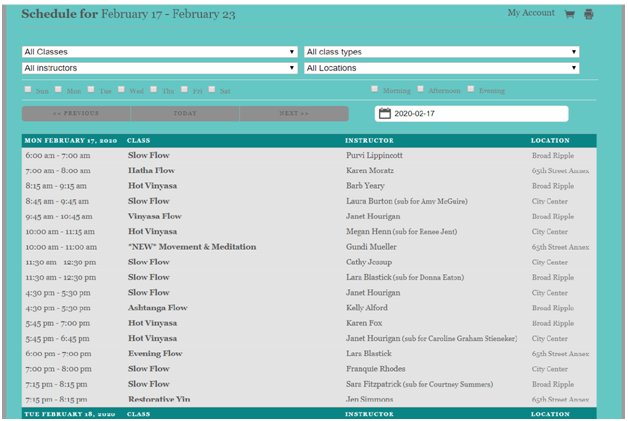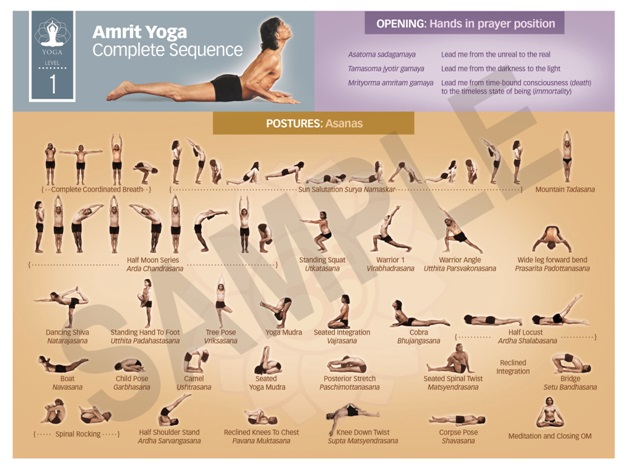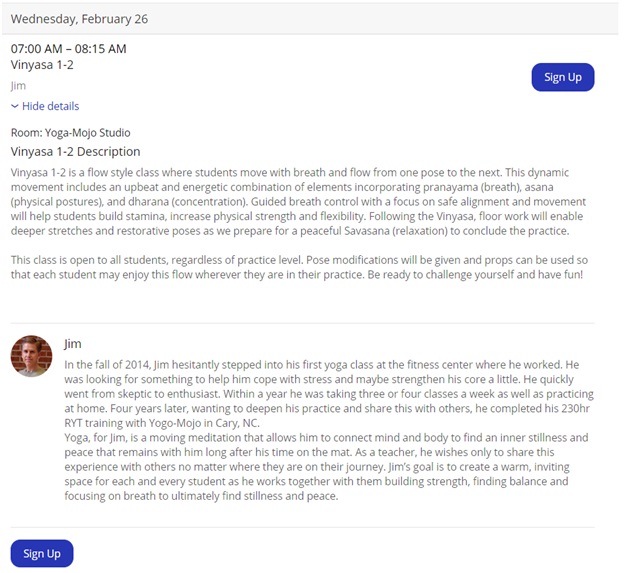
How to Make a Yoga Studio Schedule?
As a studio manager or owner, you should understand how to make a yoga studio timetable. It is prepared like how a class teacher prepares a lesson plan.
Generally, a yoga studio schedule includes the following:
- Number of classes taken every week or each day
- Type of yoga lesson to teach
- Is the class personal or group-based?
- What will be the class pricing?
- Yoga teachers who will take the class
- Does the class schedule need prior booking
And various other details.
There are two ways to make a yoga studio schedule. One is offline, where you take the pain in writing your yoga schedule and handling everything manually, like bookings and payments, attending phone calls, and making teacher and student bookings.
Another approach, which is popular and effective nowadays, involves using online scheduling and management software to make your studio timetable.
This can be done with your mobile PC or tablet and shortened to: “…and takes only a few minutes if you have everything planned and are ready to customise your schedule the way you want.

Many online booking and management software offer yoga class schedule templates for yoga studios, with elegant designs and even better images.
Advantages of using online management software or an app to schedule your classes:
- Time Efficiency: As a yoga business owner, you get ample time for other productive work or personal life.
- Strategic Planning: You can maximise your yoga schedule strategically with your time, increasing your revenue and business.
- Increased Productivity: You’ll be more effective in handling each task, boosting your overall productivity.
- Clear Overview: You’ll know when you’re free to take classes or schedule a private client weekly.
- Financial Management: You can easily manage your finances and bills by obtaining monthly financial reports.
These are fully scheduled, making them the perfect choice for yoga and other fitness and pilates studios that want to track their progress and stick to their goals.
Booking systems like KRIYA also help you manage clients, classes, teachers, subscriptions, class passes, and events, precisely schedule your rooms and teachers, and track attendance.
This means that making yoga studio schedules online makes things easier for yoga studios. It has a convenient interface where your students see all available instructors in one calendar and then choose a time that suits them. You are free to set up the number of students in the class.
Depending on the service, you are allowed to send confirmations to provide your students with additional instructions, booking, or contact info.
Advantages of using online management software to schedule your classes
- As a yoga business owner, you get ample time for other productive work or personal life.
- You can maximise your yoga schedule strategically with your time, and this will increase your revenue and business.
- You’ll be more effective in handling each task, increasing your productivity.
- You’ll know weekly what days you’re free to pick up classes or schedule a private client.
- You can easily manage your finances and bills and get monthly financial reports.
How to make your Timetable?

If you are taking a new class for the first time, you must create a yoga schedule as a beginner for students new to yoga. You can aim for a class thrice a week or daily if you desire a specific duration, allowing your students to ease into learning yoga comfortably.
The schedule should not make the student take yoga as a complex subject; instead, the student should learn by resting and understanding the concept. It is always advised to go slow when teaching yoga.
Then, after about two months, you should consider increasing the number of weekly classes, ensuring at least one day of rest for your clients to rejuvenate.
With an online booking system, you can present the yoga studio schedule in a grid or list format.
A typical layout or format will have the following information.
Day | Time Class Starts | Time Class End | Name of Class | Name of Yoga Teacher | Sign Up Button
This makes the students look for a schedule of classes on the studio website or app and book them.
The schedule might also mention if there is a substitute instructor and the specific location if a yoga studio has more than one. Your client can click on the teacher’s name to get a bio or the class to get a class description.
You can list and number these to make your students’ schedules easier, for example, Vinyasa Yoga Level 1, Hatha Yoga 1, or Yoga Flow.
You can also name specifics, such as Yoga for beginners, Yoga for Newbies, Foundation classes, Basics in meditation, etc.
Many yoga studios go out of their way to welcome new students and even have special rates and sections for beginners on their schedule or website.
Your class schedule should clearly state everything that a student or client wishes to know before he or she books your class.
Yoga class-level schedules

After outlining the general aspects of a yoga studio schedule, it’s crucial to delve deeper into the content of your classes. Differentiating class levels can significantly aid your students in choosing the right class for their abilities. Let’s explore what typical beginner and advanced yoga class schedules might look like.
Yoga Class levels state the class experience and are often described as Levels 1, 2 and 3. It’s always best to mention the class levels so your students are not confused and join the right class.
Level 1 schedule: This typically caters to beginners, referred to as ‘newbies’, and focuses on foundational yoga practices. The pace should be slow yet progressively effective. You’ll also find students of all skill levels and experience in Level 1 classes because they may prefer that particular time, pace or temperature.
- If you cater to all levels of your schedule, then your students should be familiar with some basic form of yoga.
- If you make a schedule for Vinyasa yoga, students must know Surya Namaskara or Sun Salutations.
If you are preparing a schedule for beginners, it’s best to have at least fifty classes of that style to cover. Some yoga studios do not distinguish between the levels because they believe you should be able to join any class. It’s more helpful, though, to offer a well-conceived Level 1 class to beginners.
Level 2-3 schedule: This yoga schedule is not for beginners but for students who have at least practised yoga for a year or so before joining your class. Your class schedule should have asanas or yoga poses that are more understandable to students.
Therefore, as a yoga teacher, you have to be able to serve and take care of everyone in your yoga schedule. You also have to teach new students what yoga is in an accessible way. Your words need to be simple, clear, and easy to follow. You also have to be able to offer a challenge and keep it interesting.
Why Yoga Scheduling Matters – Find Here
The yoga class schedule for beginners should have the following yoga sequence.
- Sukhasana
- Adho Mukha Svanasana
- Surya Namaskar
- Vrksasana
- Utthita Trikonasana
- Utthita Parsvakonasana
- Dandasana
- Paschimottanasana
- Baddha Konasana
- Upavistha Konasana
- Navasana
- Salabhasana
- Setu Bandha Sarvangasana
- Viparita Karani
- Reclining Twist
- Savasana
The yoga class schedule for the advanced level should include the following yoga sequence:
- Virasana
- Adho Mukha Svanasana
- Surya Namaskar
- Vrksasana
- Utthita Trikonasana
- Utthita Parsvakonasana
- Ardha Chandrasana
- Adho Mukha Vrksasana
- Ardha Navasana
- Bhujangasana
- Salabhasana
- Makrasana
- Salamba Sarvangasana
- Baddha Konasana
- Janu Sirsasana
- Paschimottanasana
- Marichyasana III
- Savasana
Remember, as a well-trained yoga teacher, you can adjust your yoga schedule and sequence according to your students’ needs.
Once your student finds a reasonable class description and time, they will click on the class and read more about it. Then, before they click to sign up for your class, they can also click on the teacher bio, learn more about him or her based on their experience level, and book their scheduled class.

Optimising Your Yoga Studio Schedule
Once you’ve got the basics down and have chosen your preferred method of scheduling, either manually or through a digital platform, it’s essential to optimise your schedule further to meet your clientele’s diverse needs and preferences. Here’s how:
- Feedback Loop: Regularly collect feedback from your students. Their insights can guide adjustments to your schedule or the types of classes you offer.
- Seasonal Considerations: Depending on the time of the year, offer classes that resonate with the season. For instance, Yin Yoga might be soothing during winter, while an energising Vinyasa flow could be apt for summer.
- Special Workshops: Intermittently sprinkle in special workshops or theme-based classes. Examples include ‘Yoga for Stress Relief’, ‘Yoga for Back Pain’, or ‘Intro to Pranayama’.
- Diversity and Inclusivity: Make sure your schedule has something for everyone, from seniors and expecting mothers to children and individuals with specific health concerns.
- Peak Hours and Class Duration: While it’s vital to understand the peak hours students prefer, also vary the duration of your classes. Mix standard 60-minute sessions with shorter 30-minute and longer 90-minute sessions to cater to different needs.
- Class Sizes and Personal Attention: While larger group sessions are standard, consider offering smaller groups for more personalised attention.
- Complementary Therapies: Beyond traditional yoga, consider integrating complementary therapies like meditation or sound bowl healing sessions.
- Embracing Hybrid Models: In this digital era, offer hybrid classes where students can choose between attending in person or streaming the class online.
- Guest Instructors: Periodically, bring in guest instructors to offer a fresh perspective and new techniques.
- Consistency: Ensure popular classes maintain consistent timings each week, aiding students in establishing a regular yoga routine.
- Gearing Up: If certain classes require specific props, like straps or blocks, notify students beforehand, especially if they need to bring their own.
Your calendar in the booking system should provide a visual reminder of yoga practices, from Bikram to Vinyasa, so that your student finds the best class for his or her level of yoga knowledge.
Running a yoga studio demands expertise in yoga and efficient management and organisation. Leveraging modern tools, like online scheduling software, empowers studio owners to streamline their operations, save time, and enhance the experience for their students.
By embracing these tools and methods, yoga instructors can offer a balanced and accessible schedule that caters to beginners and advanced students.
If you want to elevate your yoga business, now is the time to invest in these digital solutions and truly harmonise your studio’s inner workings with the calm and focus you teach in your classes. Take the next step today and bring tranquillity to your management style and yoga sessions.
Takeaways
Creating an effective yoga studio schedule goes beyond merely jotting down times and assigning instructors. It’s about crafting a holistic experience for your students, understanding their preferences, and adapting to their needs.
Whether using pen and paper or the latest scheduling software, remember that the heart of every class is your students’ well-being and growth. Stay flexible and keep evolving, and your yoga studio will flourish.
